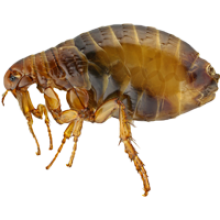

Welcome To The World Of Fleas
Introduction
Historically, fleas have been involved in devastating epidemics of plague throughout the world. Today in the U.S., fleas primarily are annoying biting pests of pets and people. The most common species is the cat flea, Ctenocephalides felis. However, other species of fleas that are parasites of rodents are involved in the transmission of plague and murine typhus, both of which occur in the southwestern U.S.
RECOGNITION
Adult fleas typically are about 1/8 inch long, oval, and reddish-brown. They are wingless, and their bodies are very thin, so thin that they can move freely through fur or feathers of their host. They possess very large hind legs that are used for jumping and a very slender proboscis (beak) that extends forward when the flea takes a blood meal. At rest, the proboscis projects downward and backwards between the legs, but it cannot be seen without the aid of a microscope. Similarly, recognition of flea larvae and pupae typically requires the use of a microscope. To the unaided eye, the legless larvae resemble tiny whitish "worms." Flea pupae most likely would not be recognized at all because they are encased within a sticky cocoon covered by incorporated soil particles and small items of debris from the habitat in which the larvae develop.
BIOLOGY
Under favorable conditions, the pupal stage may last 4-14 days or up to a year under harsh conditions. The pre-emerged adult remains in the cocoon for up to 20 weeks, where it is protected from adverse conditions, including pesticides. Adults are stimulated to emerge from the cocoon by mechanical depression of the cocoon, an increase in temperature, and possibly vibrations. Larvae and pupae are typically found where the animal sleeps or frequents. Adults usually begin to seek a blood meal on the second day after emergence, but can live for several months on stored body fat. Once on a host, they tend to spend all of their time on the host, feeding, mating, and laying eggs, unless dislodged. Although they have a preferred host, they will readily bite and can survive using other species as hosts. Depending on conditions, adults usually live only several days because normal cat grooming removes up to 50% of the fleas; otherwise, they can survive about a year.
HABITS
Adult cat fleas usually reside and feed on a single host dog or cat. Pet to pet transfer occurs when pets interact and when they sleep together, but transfer of fleas from infested pets to pet owners appears to be uncommon. The usual way in which a human gets bitten by a cat flea is when a "hungry" adult emerges from its pupal cocoon and jumps onto a person walking in their vicinity. The presence of flea bites on a person suggests that the home (or a barn) is supporting the development of flea larvae, which can be a continuous source of adult fleas that then infest your pets.